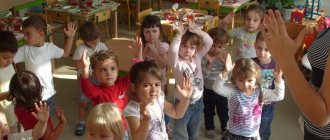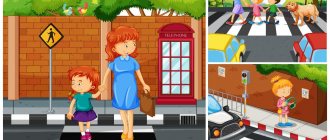Progress of the lesson
(Children sit in a circle with the teacher)
.
after class, the teacher tells all the children to go to the toilet and get ready for a walk) Guys, let’s look at the sequential dressing scheme (look at the diagram, repeat the dressing order)
.
Guys, today we will dress and undress in an unusual way, look, I have two movable belts. One with a butterfly for girls, one with a ladybug for boys. Today we will compete with you. At my command, you begin to get dressed, but do not forget that you and I are dressing in the correct sequence. Remember to be quiet, don't shout, push or rush, and leave your locker with clothes neatly folded. I will monitor your progress. Whoever gets dressed comes up to the moving ribbon and raises the butterfly or ladybug one higher, whose team gets dressed faster receives small badges. Let's start getting dressed.
“ Summary of a walk in the senior group “Birds”
»
Type of activity: Cognitive and research.
Format: group .
Goals and objectives:
1. Learn to distinguish birds by plumage, size, habits.
2. Develop observation, memory, speech; develop movements, dexterity, speed of reaction, action on a signal.
3. Cultivate an emotionally positive attitude towards birds : kindness, responsiveness, desire to help and do good deeds; hard work.
Program content:
The children go out to the site.
The teacher begins
— observation of wintering birds; name what groups birds are divided (wintering and migratory)
birds. Which birds are wintering: crow, woodpecker, tit, bullfinch, waxwing, nuthatch, capercaillie, sparrow, crossbill, etc. Migratory birds include: swift, oriole, heron, starling, nightingale, swallow, etc.
— didactic task “Who is screaming?”
;
consolidate children's knowledge about birds; chik-chirik (sparrow, kar-kar (crow), peek-a-boo (cuckoo, quack-quack (duck), knock-knock (woodpecker)
, etc.
— outdoor game “Birds in a Cage”
;
"Birdcatcher"
; teach children to act on a signal and navigate in space;
Outdoor game “Birds in a Cage”
;
Half of the children stand in a circle, holding hands, arms raised with “collars”
- this is a cell.
The second half of the children runs in and runs out into the “collar”
.
At the teacher’s signal (the cage closes), the “collars”
are lowered, the caught children name any migratory or wintering bird and leave the cage. The game is repeated 2-3 times.
Outdoor game "Birder catcher"
;
Children stand in a circle and choose a “bird catcher”
- the driver, who is blindfolded:
“One, two, three
, catch the birdcatcher,” the children run away, and the birdcatcher tries to catch someone, then they change.
The game may become more difficult with an increase in birdcatchers
.
Take-out materials: bird food, cheesecakes, sleds, ice cubes.
Labor activity: Shovels for labor activity.
Individual work: D/i “Name the bird with the right sound”
.
-Research part: observation and study of bird tracks.
The walk ends.
"Return from a walk"
— education of cultural and hygienic skills (monitor your appearance: dust off clothes, wipe shoes)
;
- fostering a sense of mutual assistance.
I draw children's attention to their appearance. I remind you that you need to hang clean clothes in lockers and hang damp ones on radiators.
“Getting ready for lunch. Dinner"
Tasks:
Educational objective:
To teach children to conscientiously perform the duties of a dining room attendant: setting the table. Learn to express your thoughts coherently and consistently, based on a diagram. Learn to evaluate the results of your work with the help of an adult.
Developmental task:
Develop dialogical speech.
Educational task:
1. Instill in children a desire to participate in joint work activities.
2.Improve cultural and hygienic skills: carefully wash and dry your hands, hang the towel in place .
3. Create conditions for improving the quality of children’s self-care activities during preparation for meals.
4. Form the habit of a healthy lifestyle (prevention of poor posture while eating)
;
5.Continue to develop a culture of behavior while eating: use cutlery correctly (tablespoon, teaspoon, fork)
; ability to use a napkin carefully; do not crumble bread, chew food with your mouth closed, do not talk while eating.
6. Follow medical prescriptions for individual nutrition.
7. Cultivate the ability to calmly wait for the next dish to be served, politeness (thank you for the food, the need for cleanliness and neatness.
8. Introduce children to a set of exercises to optimize the functioning of the digestive system.
9. Foster a conscious attitude towards health through practical mastery of a gymnastics complex.
10. Table setting: conversation with the attendants; familiarization with the menu, announcing it to children; attracting children's attention to the aesthetic design of tables.
11. Attracting children's attention to food; individual work to educate food culture; rules of etiquette; performance assessment.
12.Getting ready for bed: hygiene procedures; creating conditions for organizing sleep ; going to bed.
Preliminary work:
- Examining dishes while eating;
— Guessing and learning riddles about dishes;
— Compiling a descriptive story about a bird using a diagram.
— Reading V. Bianchi’s “Sinichkin’s Calendar”
Equipment: napkins, cutlery (spoons, forks, knife, tableware (deep plate, shallow plate, cup, bread box, napkin holder, for table setting.



